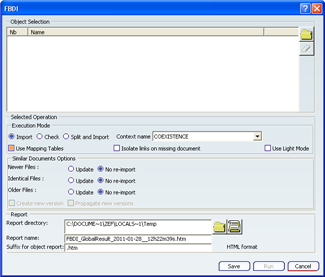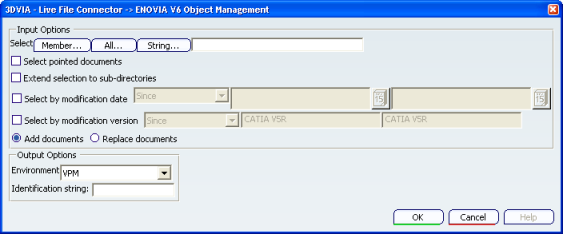Open the Batch Monitor:

Double-click the FBDI line in order to open
the FBDI dialog box.
Note:
All the parameters except Use Light Mode option in Select the files to Import dialog box are retained from the previous session of FBDI Import.

Click  in the Object Selection section to choose the
Input data
in the Object Selection section to choose the
Input data
The ENOVIA V6 Object Management dialog box opens.

The following options are available in the Input Options section:
- Select
Member... to open the CATIAFileBox (browser) window. Select one or several CATIA documents and click
Open. The selected object will be listed in the FBDI window.
- You can select the following:
- Add documents. This option is always checked
by default.
Note:
Both options Add documents and Replace documents
are not taken into account by FBDI since the FBDI tool creates new components
in ENOVIA database.
In the Output Options section of the
File > ENOVIA V6 Object Management window, you can
define:
Click OK.
The FBDI window is
open, with the selected object you want to migrate in the Object Selection area.
In the Selected Operation:
Execution Mode: area of FBDI dialog box, select one of the three FBDI parameters:
Context name: choose a context in the
list to import data based on the context map
selected. For more information, see About Context Administration.
Click the Isolate Broken Links option to
migrate documents even though some links are broken (missing target
document or missing target feature). Import from V5 becomes possible
if the corresponding link can be isolated.
For more information about this setting, please read
About FBDI Principles.
The Batch solution for FBDI migration allows Asynchronous Migration. For more information about this mode, see About FBDI Principles. Select the Use Mapping Tables options to launch an Asynchronous Import.
Click the Use Light Mode option to migrate only the necessary core data of a document.
A warning message is displayed. For more information about this setting, please read
About Light Import.
Similar documents options section has Newer Files, Identical Files, and Older Files options.
For each option, you can select one of the following:
For more details on this setting, see Importing V5 Data by using Mapping Tables.